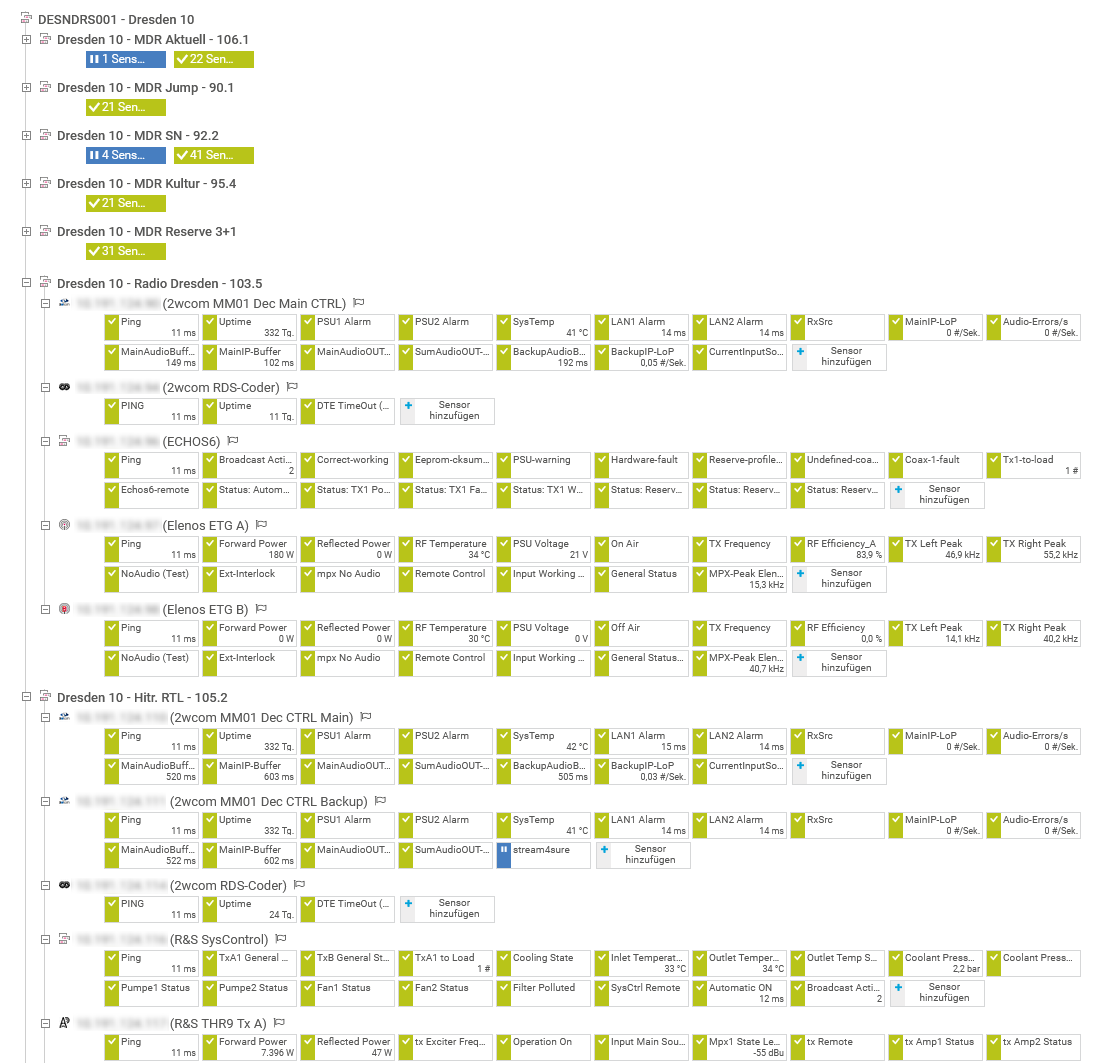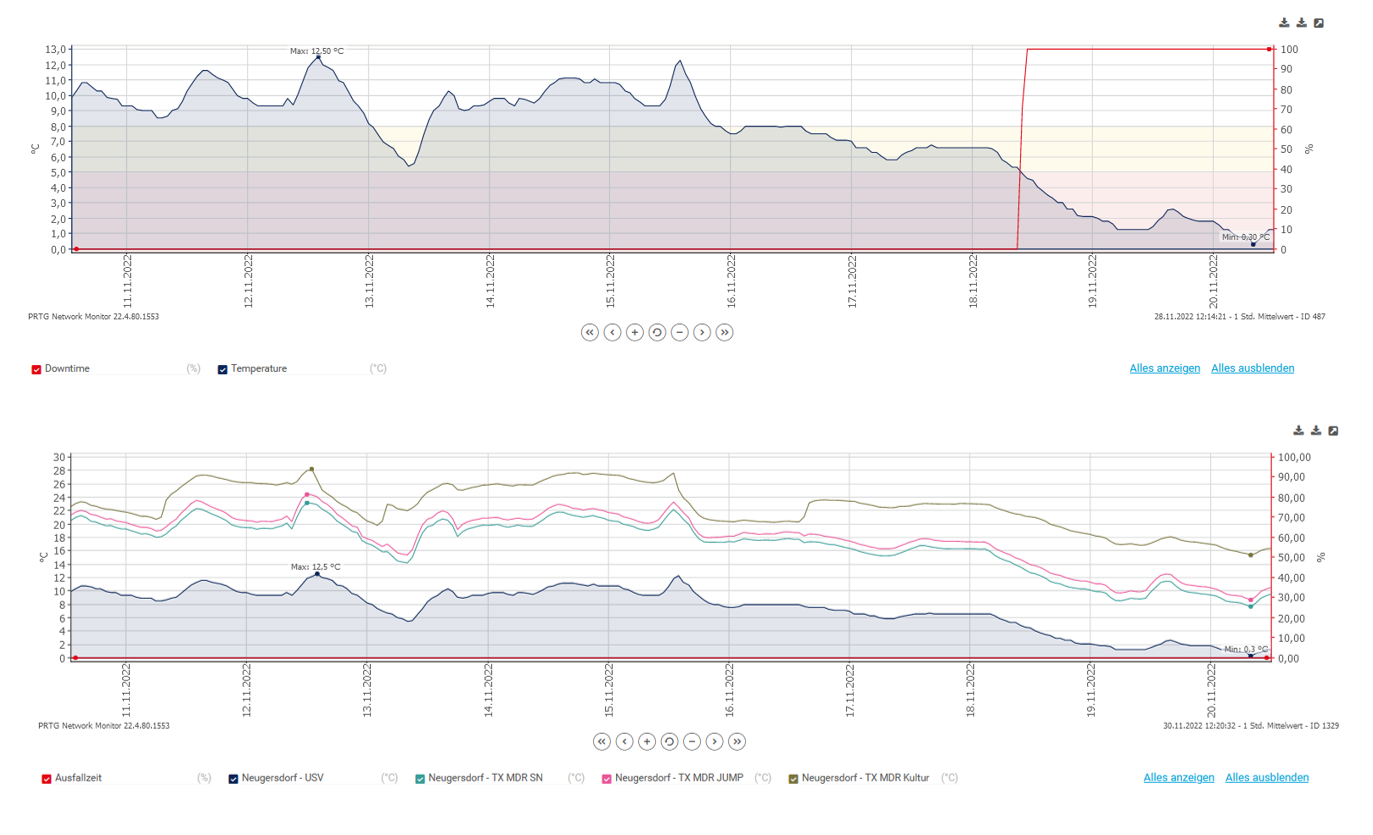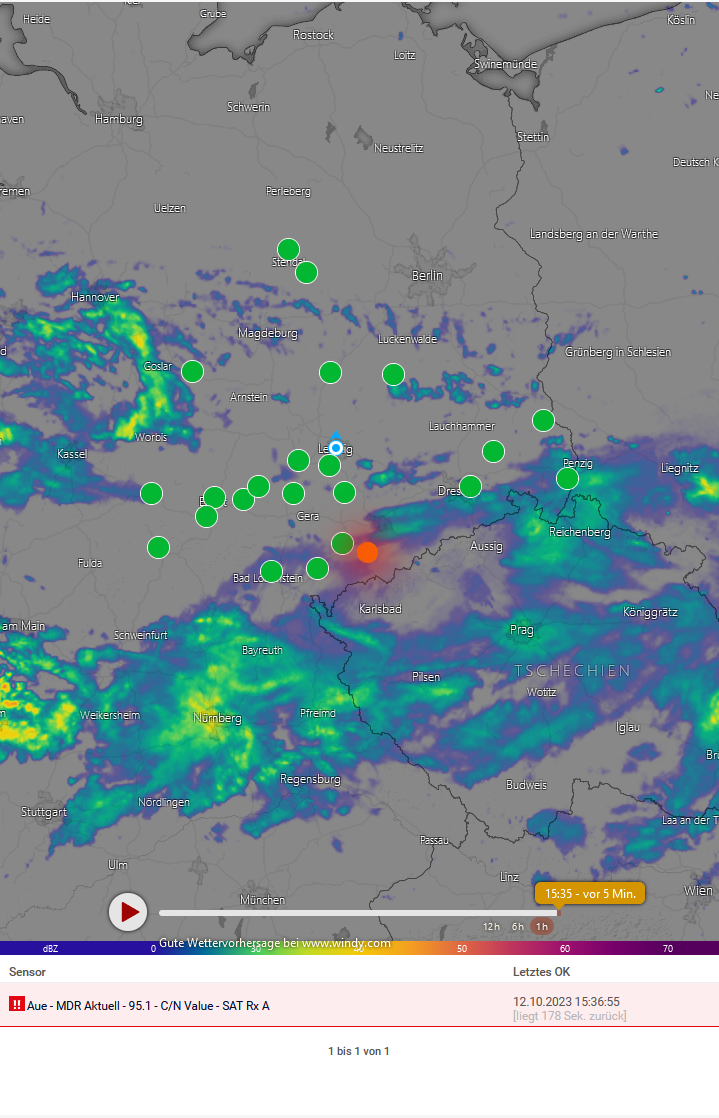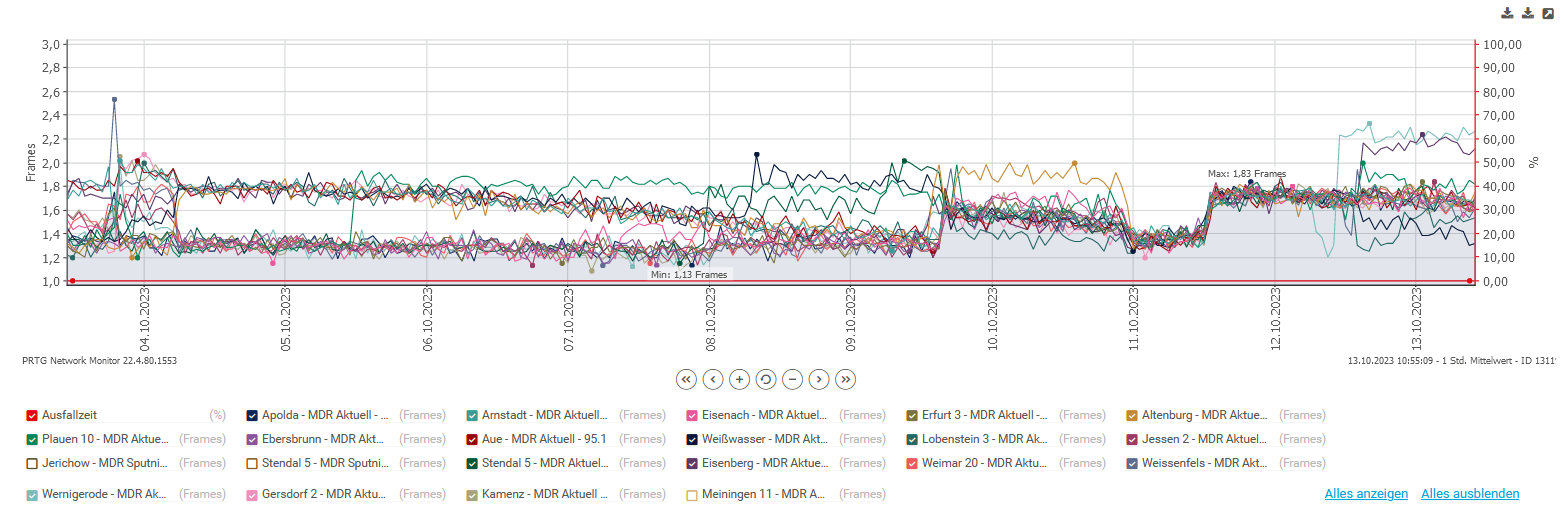An upstream supplier, DIVICON MEDIA has been handling nearly all of the technical and organizational tasks for the modulated lines of various radio stations for years, and operates FM frequencies as well as DAB+ multiplexes at numerous broadcasting sites throughout Germany. DIVICON MEDIA’s customers include well-known broadcasters from the public and private sectors, including MDR, Antenne Thüringen, NRJ, and Nordseewelle.
iAbout DIVICON MEDIA
![]() DIVICON MEDIA is an independent, full-service provider and consultant for public and private broadcasters that specializes in the planning, implementation, operation, and monitoring of broadcasting operations and IT.
DIVICON MEDIA is an independent, full-service provider and consultant for public and private broadcasters that specializes in the planning, implementation, operation, and monitoring of broadcasting operations and IT.
Its services include the supply and transportation of audio signals, comprehensive studio operations and site networking (contribution), the processing of data, and the broadcasting of content (distribution) via FM, DAB+, and streaming.
![]()

“In order to provide our customers with the best possible service, we must incorporate all the components at our various locations into a central monitoring tool. Round-the-clock monitoring is the only way to detect errors at an early stage and avoid outages.”
Silence can be costly
In the world of broadcasting, even the shortest audio outages can have serious consequences for both public and private radio stations.
Example: If an hourly commercial break is malfunctioning and leads to 30 seconds of silence, this seemingly short outage has significant economic consequences. After all, advertisers invest large amounts of money to broadcast during prime times. These 30 seconds of silence every hour not only result in major financial losses for advertisers, but also jeopardize the reputation of the broadcasting company.
Moreover, in the broadcasting industry, it is vital that companies adhere to telecommunications-related regulations and comply with legal requirements. Non-compliance with these requirements can have serious consequences, including hefty penalties or even the revoking of licenses by the German Bundesnetzagentur (regulatory agency for telecommunications).

“The broadcasting industry is extremely careful to avoid disruptions and outages. It’s not just about money, but also legal obligations and reputations.”
Monitoring as the key to interruption-free service
“In order to provide our customers with the best possible service, we must incorporate all the components at our various locations into a central monitoring tool. Round-the-clock monitoring is the only way to detect errors at an early stage and avoid outages”, says Marten Hölzer, Broadcast Administrator at DIVICON MEDIA.
Errors must be spotted (and resolved) quickly, ideally before outages occur. Broadcasting systems – as well as studio technology and IT environments – must therefore be monitored comprehensively and around the clock. DIVICON MEDIA:
- Monitors its own services;
- Monitors the technology of its customers;
- Monitors the services of external service providers who (among other things) supply lines and antennas.
Concretely, this involves the monitoring of vital system parameters, the monitoring of contractual products and services to immediately identify errors or deviations from normal operations, and the provision of analyses and evaluations. Marten Hölzer, Broadcast Administrator at DIVICON MEDIA, is in charge of monitoring at the company and relies on the Paessler PRTG Network Monitor.
Every day, he must overcome a variety of different challenges:
- 400 locations: Studio technology, broadcasting technology, antennas, lines, IT networks and infrastructures…in the company’s own data center, at customer locations, at service providers, or spread out across Germany.
- 600 audio signals: Each bearing the utmost importance for the broadcasting provider.
- Environmental conditions: Bad weather can affect the quality of transmissions, while high temperatures can cause systems to crash. In order to reliably identify the causes of errors and disruptions, environmental conditions must also be included in the monitoring.
- Diverse environments and components: Broadcasting systems, radio studios, IT environments, environmental values, weather data: all this and more must be incorporated and connected in a single system to identify and localize errors (and their causes) across all departments, and fix these errors as quickly as possible.
- Round-the-clock monitoring: The DIVICON MEDIA Network Management Center (NMC) must guarantee the 24/7 availability of all components.
- 99.99%+ overall availability: DIVICON MEDIA guarantees a high level of availability that exceeds the agreed-upon number in SLAs with customers (99.9%), and is constantly working to inch closer and closer to 100%.
To meet all these requirements, Hölzer set up the DIVICON MEDIA NMC. At the NMC, 900 values arrive per second, while the results of 77 million queries from 50,000 sensors arrive every day.
In total, 3.5 GB of monitoring data are received per day. To maintain an overview, the NMC needs a well-structured tool that prioritizes, sorts, and clearly displays all the data. Hölzer explains the basic principle:
“PRTG comes with a tree structure that provides for quick and easy navigation to different locations, thereby making it possible to assist with maintenance or localize errors such as power outages. This structure is ideal for in-depth analyses of our sites. It provides for quick and easy access to detailed information, which in turn lets us identify potential problems and take targeted measures to remedy them. As a result, we are usually able to inform our customers within 20-30 minutes of outages or irregularities in their broadcasting operations, and of errors that have already been eliminated.”
All relevant values and data are visible at a glance, ensuring a clear and precise overview of the status of the sites and allowing for an immediate response to errors. At the Dresden site alone, for example, more than 700 sensors monitor the simultaneous broadcasting of 29 programs.
 At the Dresden site, the DIVICON MEDIA NMC monitors 29 programs with more than 700 sensors, all clearly displayed in the PRTG tree structure
At the Dresden site, the DIVICON MEDIA NMC monitors 29 programs with more than 700 sensors, all clearly displayed in the PRTG tree structureBasic monitoring principles
“For us, it is vital that we act instead of react. With PRTG, we can keep a constant eye on the status and performance of all our systems, and proactively take action before errors lead to outages. PRTG is made unique by its outstanding usability, which enables us to always stay in the know and provide more security for our operations, our service providers, and our customers,” says Marten Hölzer.
Usability
For Hölzer, usability and a simple configuration are the two main requirements for smooth and agile monitoring. With PRTG, changes to the existing infrastructure (e.g., the replacement of equipment at the broadcasting site or the installation of new or additional technology) can be made both quickly and effortlessly.
Hölzer adds: “Given the scope of our monitoring environment, our tool must offer as many default and automated features as possible. The most important functions must be provided out of the box. At the same time, we must be able to make individual adjustments and consolidate components to display complex relationships and services in their entirety. PRTG provides us with the default functions that make daily monitoring possible, as well as the flexibility to customize our monitoring to meet our extremely specific requirements.”

“You won’t get a comprehensive overall picture by simply collecting more monitoring data. You have to combine and compare data, and map out services in their entirety to achieve real added value. PRTG provides us with the means to apply creative solutions to complex problems.”
Alerts
Reliable and targeted alerting options also play a major role. PRTG alerts allow the DIVICON MEDIA NMC team to maintain an overview of all the systems involved in their daily operations, and to immediately take action when needed.
With PRTG, the team can pinpoint and determine the causes of disruptions. As a result, the field service staff can promptly be notified and make their way to the affected site with spare parts or replacement devices to start troubleshooting immediately.
In addition, PRTG makes it easy to define escalation routines that ensure no alerts are overlooked.
Publication of data
According to Hölzer, another important requirement involves the publication of data. Data must be presented to various target groups (i.e., the DIVICON MEDIA NMC team as well as DIVICON MEDIA customers) in a way that is specially tailored to meet the needs of each group.
This data includes information on the status and availability of services and systems, as well as information on the types of disruptions and errors that occur at each of the locations.
In addition to a ticket system, Hölzer relies on the PRTG Maps feature to communicate with customers. With this feature, he can generate HTML-based dashboards using drag & drop, and present data in a clear and easy-to-understand manner.
 Custom PRTG map at DIVICON MEDIA showing site availability
Custom PRTG map at DIVICON MEDIA showing site availabilityPRTG in practice
Hybrid monitoring
Hölzer adopts many of these means to monitor a variety of services and devices. Among other things, he uses traps or syslog messages to record and evaluate time-critical parameters. These messages make it possible to log all processes to the second, but can be problematic if the connection is lost.
In such a case, Hölzer uses SNMP with polling intervals between 30 seconds (for critical parameters) and 5 minutes (for the continuous monitoring of static values such as configurations). In the event of a disruption, Hölzer is immediately alerted via the SNMP sensors and can subsequently connect to the web interface of the affected device remotely to analyze the problem.
Alert redundancy
DIVICON MEDIA relies on redundancy for its systems, as well as in the lines to individual locations. Hölzer also set up a redundant solution with regard to internal alerts that includes the use of dashboards and notifications via email and messenger services.
This solution guarantees that alerts reach the respective operators in the DIVICON MEDIA NMC, even under difficult conditions. Alert redundancy allows the DIVICON MEDIA NMC to promptly take action when situations arise, and thereby ensure uninterrupted operational continuity.
Trends and data aggregation
While monitoring and managing complex systems, it is also important to identify trends and interrelationships among the measured values. This not only makes it possible to analyze errors, but also to identify correlations that might otherwise go unnoticed and cause serious damage.
Among other things, it is extremely important to monitor changes in temperatures: first of all, temperature fluctuations can be a sign that a device is malfunctioning. In addition, they can have a significant impact on the performance and stability of systems.
All temperatures at each location must therefore be monitored around the clock. By consolidating temperature data in an SNMP Custom String sensor in PRTG, you can easily recognize deviations and anomalies – and determine whether a single device is affected or the entire site.
The identification of trends and the targeted consolidation of data not only help DIVICON MEDIA to increase the reliability and stability of its broadcasting systems, but also to save money in the long run by avoiding costly outages. PRTG enables DIVICON MEDIA to quickly process and analyze relevant information, and thereby ensure that all its systems are running smoothly and reliably.
 Temperature graphs provided by a PRTG SNMP Custom String sensor
Temperature graphs provided by a PRTG SNMP Custom String sensor
Information for service providers
DIVICON MEDIA not only uses PRTG to monitor its own and its customers' systems, but also to monitor lines, antennas, and temperatures at various sites – services that are mainly provided by service providers. Among other things, Hölzer monitors the quality of lines (main and backup), which lets him quickly detect packet losses and initiate corrective measures at once.
DIVICON MEDIA also uses PRTG to supply relevant information to external service providers. If PRTG detects an anomaly in a service, the NMC team can immediately notify the responsible carrier with specific instructions or a description of the problem, and thereby maintain the quality of the transmission.
The service provider benefits from DIVICON MEDIA’s early warning system, and can fix any problems before listeners notice that something is wrong.
SNMP Custom String sensors
The DIVICON MEDIA NMC team uses numerous PRTG SNMP Custom String sensors which have been specially tailored to meet their needs. By consolidating several channels in an SNMP Custom String sensor in PRTG, correlations between different errors can be displayed clearly.
Sensor Factory sensors
Hölzer also uses formula sensors (Sensor Factory sensors). As with SNMP Custom String sensors, these sensors make it possible to consolidate several sensors into one. Sensor Factory sensors also allow for unrestricted configurations via logical operators and calculations in the sensors themselves. This makes it possible to map complex dependencies across multiple devices, and thereby to manage an entire service comprised of several subcomponents.
 SRT protocol during an audio transmission with packet loss (LoP)
SRT protocol during an audio transmission with packet loss (LoP)Dashboards and customer interfaces
DIVICON MEDIA provides its customers with custom dashboards containing comprehensive overviews of the customer’s broadcasting area, as well as potential malfunctions and disruptions. Events are displayed clearly, allowing customers to easily understand what is happening. Thanks to these intuitive dashboards, DIVICON MEDIA is able to build trust and ensure maximum transparency.
Some customers do not use a conventional line connection at the broadcasting sites, but instead feed the audio signal via a satellite-based connection. In this case, the weather conditions are extremely relevant. Hölzer therefore created a custom solution with the help of a dashboard that incorporates current weather data in the form of a map in the background, while positioning the sensors of the individual broadcasting stations over the background geographically.
An additional graph (with data from an SNMP Custom String sensor) with all the broadcasting stations (on the map) provides for more detailed information, if needed. With this map or dashboard, the customer can immediately recognize when bad weather risks affecting the quality of their transmissions, and take action accordingly.
 Custom PRTG map at DIVICON displaying the broadcasting stations on a weather map
Custom PRTG map at DIVICON displaying the broadcasting stations on a weather map Detailed analysis of all satellite signals displayed in the weather map
Detailed analysis of all satellite signals displayed in the weather mapConclusion
PRTG enables DIVICON MEDIA to implement a wide range of monitoring measures to meet (and even exceed) its own quality requirements, as well as those of its customers. Outstanding usability, combined with dependable alerts and the flexible integration of components, provides for maximum reliability and ensures the company’s broadcasting network always runs smoothly.
Customers and service providers alike benefit greatly from the advanced and comprehensive monitoring environment set up by Marten Hölzer and his team at the DIVICON MEDIA NMC. The feedback from customers has been so positive, that DIVICON MEDIA has even decided to offer monitoring as an independent service. As a result, the Network Management Center – as well as Marten Hölzer’s team – are currently being expanded.
“PRTG allows us to provide our customers with the best possible service. In fact, we regularly exceed the requirements of our service level agreements. Monitoring with PRTG has been so successful, that we’ve even added it to our business model: monitoring as a service in the radio broadcasting sector,” concludes Franz Coriand, CEO of DIVICON MEDIA.
Check out some other case studies
👉 You can find more customer success stories linked here, with a PDF download available for each case study.
 Published by
Published by 



.jpg)






